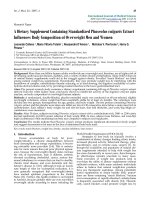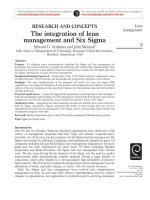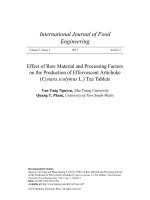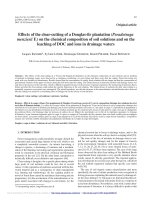Nutritional composition of raw, malted and Popped finger millet (Eleusine coracana) varieties
Bạn đang xem bản rút gọn của tài liệu. Xem và tải ngay bản đầy đủ của tài liệu tại đây (655.31 KB, 9 trang )
Int.J.Curr.Microbiol.App.Sci (2019) 8(2): 966-974
International Journal of Current Microbiology and Applied Sciences
ISSN: 2319-7706 Volume 8 Number 02 (2019)
Journal homepage:
Original Research Article
/>
Nutritional Composition of Raw, Malted and Popped Finger Millet
(Eleusine coracana) Varieties
Soubhagyalaxmi P. Hiremath* and K. Geetha
Department of Food Science and Nutrition, University of Agricultural Sciences,
Bengaluru, Karnataka, India
*Corresponding author
ABSTRACT
Keywords
Finger millet,
Nutrients, Malting,
Popping
Article Info
Accepted:
07 January 2019
Available Online:
10 February 2019
Finger millet commonly known as Ragi is a rich source of several nutrients. An
investigation was undertaken to study the nutritional composition of raw, malted and
popped finger millet varieties. Five varieties of finger millet namely GPU 66, GPU 67,
GPU 71, MR 6 and PR 202 were investigated for their nutritional contents before and after
processing such as malting and popping. The nutrients analysed for raw, malted and
popped finger millet varieties were moisture, protein, fat, crude fibre, ash and total dietary
fiber. Carbohydrate and energy values were computed. Protein content of raw finger millet
varieties ranged from 6.25 to 11.87 g/100g. Malt flour crude fibre ranged from 2.35 to 3.10
g/100g and that in popped flour from 2.00 to 2.45g/100g.GPU 66 and GPU 67 were found
to be nutritionally better compared to other varieties both in raw and processed forms.
rice. It is usually used for the preparation of
flour, pudding, porridge and roti, but with the
changes in scenario of utilisation of processed
products and awareness of the consumers
about the health benefits, finger millet has
gained importance because of its functional
components (Wadikar et al., 2007). Finger
millet is mostly consumed in its native forms
but today due to urbanisation and
modernisation processed finger millet
products are of great demand. It is at most
important to see the effects of different
processing techniques on nutritional quality of
finger millet which otherwise in its native
form is of great help to mankind to
Introduction
Finger millet (Eleusine coracana) also locally
known as Ragi forms the primary food source
for millions of people in tropical and dryland
regions. It is one of the important small
millets cultivated in many South Asian and
African countries. It is one of the oldest food
crops and referred to as ‘Artha-Kandaka’ in
the ancient Sanskrit literature, which means
‘Dancing grain’. Finger millet also have
nutritional qualities superior than that of rice.
Finger millet is especially valuable as it
contains the amino acid methionine, which is
lacking in starchy staples such as polished
966
Int.J.Curr.Microbiol.App.Sci (2019) 8(2): 966-974
maintain/regulate certain metabolic disorders.
Hence an investigation was undertaken to
study the nutritional composition of raw,
malted and popped finger millet varieties.
protein, fat, crude fibre, ash and total dietary.
Carbohydrate and energy values were
computed.
The AOAC (1980) methods were followed
for estimation of moisture, protein, fat, crude
fibre, ash. Carbohydrate and energy were
computed by differential method. The total
dietary fibre was analysed by AOAC (1995)
method.
Materials and Methods
Five finger millet (Eleusine coracana)
varieties selected for study were procured
from All India Co-ordinated Small millets
Improvement
Project,
University
of
Agricultural Sciences, Bengaluru. The
varieties selected were GPU 66, GPU 67,
GPU 71, MR 6 and PR 202. They were
cleaned to remove foreign materials and
impurities. Further were subjected to malting
and popping.
Statistical analysis
For comparison of nutrient content of raw,
malted and popped finger millet two way
analysis of variance test was applied on the
means of two replications for different
varieties.
Malting of Finger millet: Finger millet seeds
were washed with water for 5 times and
soaked in water for 5 hrs. Excess water was
drained, seeds were tied in a muslin cloth and
5 kg weight was kept on it. These seeds were
germinated at 27± 3 ⁰ C for 24 hr and dried in
shade for 2 days. The germinated shade dried
finger millet seeds were subjected to kilning
and devegetated. These seeds were grounded
into flour by using the electric grinder (Plate
1) (Malleshi and Desikachar, 1986).
Results and Discussion
Percent germination of different finger millet
varieties under study ranged from 98 to 99 per
cent (Table 1) which is in tune with findings
of study by Kumari and Srivastava (2000) on
‘Nutritive value of malted flours of finger
millet genotypes and their use in the
preparation of Burfi’.
Percent malt recovery of different finger
millet varieties which ranged from 75 to 82
per cent (Table 1) in the present study is in
tune with the findings of the study conducted
by Pawar and Pawar (1997) and Malleshi and
Klopfenstein (1998) on ‘Nutrient composition
and amino acid contents of malted sorghum,
pearl millet and finger millet and their milling
fractions’. The variation in malt recovery may
be due to the moisture and fibre content in the
varieties. Higher the moisture and fibre
content lower is the malt recovery.
Popping of Finger millet:
After determining the moisture in the sample
by oven drying methods, water was sprinkled
on the grain to raise the moisture content to
19 percent, mixed well and grain equilibrated
in a closed airtight container for 24 hrs prior
to popping. After 24 hours the equilibrated
grain were added in an iron frying pan, the
temperature of which was maintained at 175200⁰ C. When popping sound was stopped the
pan was removed from the flame (Plate 2)
(Malleshi and Desikachar, 1981).
A study conducted by Shukla et al., (1986) on
of finger millet for puffing yield found that
puffing yield ranged from 66 to 95.3 per cent.
But the popping percent of the finger millet
The nutrients for the research sample in its
raw, malted and popped form were moisture,
967
Int.J.Curr.Microbiol.App.Sci (2019) 8(2): 966-974
varieties under study ranged from 31 to 76 per
cent (Table 1) which is in tune with the
findings of the study conducted by Shukla et
al., (1986) on eight varieties of finger millet
for puffing yield but not on par with the
findings of Shukla et al., (1986) on eight
varieties of finger millet.
(2010), but on par with the findings reported
by Shayo et al., (2001) where in the protein
content of malted finger millet ranged from
8.28 to 11.8 g. The protein content of the
popped finger millet under study is on par
with the findings of Madhusmita Sahoo
(2003) where in the popped finger millet
protein content was 6.2 g. After malting and
popping the protein content of finger millet
was decreased compared to raw form. The
decrease in protein content after malting may
be due to hydrolysis of native protein to low
molecular weight proteins or peptides and
increase in enzyme activity (Shayo et al.,
2001) (Table 2).
Moisture content of cereals and millets ranges
from 10 to 14 per cent. Similar trend was also
observed in raw finger millet varieties under
study which ranged from 11.9 to 12.35 per
cent. However the moisture content of the
varieties decreased in malt flour which ranged
from 6.0 to 9.1 per cent and also popped flour
ranging from 3.5 to 4.25 per cent. The reason
may be due to drying and roasting in case of
malting and in case of popping due to heating
at high temperature where there is loss of
moisture content. Similar trend was reported
in popped finger millet varieties by
Madhusmita Sahoo (2003). A study by Desai
(2009) also reported the moisture content of
raw and malted ragi to be 12.67 per cent. The
findings are also in tune with the findings of
Kumari and Srivastava (2000) on nutritive
value of malted flours of finger millet
genotypes and their use in the preparation of
burfi.
Fat is an important component of diet and
serves number of functions in the body. It is a
concentrated source of energy and also
important source of essential fatty acids. It is
also necessary for proper utilisation of fat
soluble vitamins. According to Gopalan et al.,
(2007) the fat content of raw finger millet is
1.3 g. In the present study the fat content of
raw finger millet varieties ranged from 1.3 to
1.9 g which was on par with the findings of
Kumari and Srivastava (2000) where in the fat
content ranged from 1.0 to 2.0 g and also
according to Wadikar et al., (2007) the fat
content ranged from 1.3 to 1.9 per cent. In the
present study application of processing
method such as malting decreased the fat
content which was found to be ranging from
0.8 to 1.2g/100g but popping increased the fat
content ranging from 1.60 to 2.25g/100g. This
may be because the hydrolysis of lipid and
oxidation of fatty acids take place during
germination of seeds. The hydrolysed
products do not accumulate in the seed, but
the glycerol becomes a part of carbohydrate
pool and the fatty acids are oxidised through
and β oxidation, resulting in decrease in fat
on malting (Choudhury et al., 2010).
Significant increase in fat content during
puffing was observed which may be due to
the increased polar lipids which may improve
Protein content appears to be the dominant
chemical constituent that influences the grain
hardness, milling, popping and malting
characteristics. This parameter therefore could
have as one of the basic quality indicator in
millet breeding programme. Protein content
of finger millet in general is 7.3g/100g
(Gopalan et al., 2007). In present study the
Protein content of raw finger millet varieties
ranged from 6.25 to 11.87 g/100g which was
on par with the results of the study conducted
by Shayo et al., in 2001 in which the protein
ranged from 8.91 to 12.5 g. The mean protein
content of malted grain was 8.18 g and that of
popped was 5.84g, which was slightly lower
than that reported by Choudhury et al.,
968
Int.J.Curr.Microbiol.App.Sci (2019) 8(2): 966-974
the functionality of the puffed millet flour in
processed products (Premavalli et al., 2005).
According to Gopalan et al., (2007) total ash
content of finger millet is 2.7 g. Similar trend
was also observed in raw finger millet
varieties under study which ranged from 2.05
to 2.45g. However the total ash content of the
varieties decreased in malted which ranged
from 1.75 to 2.00g/100g and popped form
ranged from 1.2 to 1.7g/100g. The reason
may be due to the removal of seed coat during
malting and due to greater concentration of
minerals present in the germ and the bran
layers than in the endosperm which contribute
to a greater extent towards the reduced
amount of total ash content in popped finger
millet (Choudhury et al., 2010). Similar
trends were observed by Shayo et al., (2001)
for malted form of finger millet and by
Madhusmita Sahoo (2003) for popped form of
finger millet.
components. During popping, the endosperm
puffs out and localized rupture of the cell wall
occurs in the expanded endosperm. In this
process, the seed coat gets removed to some
extent, which could be the reason for lower
fibre content in popped sample compared to
that of raw samples. However similar trend
was observed by Malleshi and Klopfenstein
(1998) (Fig. 1).
Carbohydrate content of finger millet is found
to be 72 g/100g (Gopalan et al., 2007).
Similar trend was also observed in raw finger
millet varieties in the present study which
ranged from 69 to 75g/100 g. However the
carbohydrate content of the finger millet
varieties increased in malted and popped
form. Carbohydrate in malted form ranged
from 77 to 79g/100g and in popped form from
83 to 85g/100g (Table 3). The reason may be
during germination, there would be partial
degradation of amylopectin and increase in
amylose content which contributes to the total
carbohydrate of malted form of finger millet
(Gokavi and Malleshi, 2000). Carbohydrate
content in popped form was significantly
higher which may be due to the fact that
popped seeds were concentrated more with
endosperm which contributes 94 per cent of
starch to the kernel (Choudhury et al., 2010).
Crude fibre is an important biological and
nutritive component of human body. It adds
bulk to the diet. A high fibre diet is used in
the prevention and treatment of constipation.
Finger millet contains 3.6 g/100g of crude
fibre. Similar results were observed in raw
finger millet varieties under study which
ranged from 2.65 to 3.40 g. The variation may
be due to genotypes. Crude fibre was found to
reduce after processing of finger millet in
present investigation. The results of the
present study showed that in malt flour crude
fibre ranged from 2.35 to 3.10 g/100g and that
in popped flour from 2.00 to 2.45g/100g.
Reduction in crude fibre content during
malting might be due to the type of grain and
degree of removal of seed coat and also due to
decrease in neutral detergent fibre on malting
which occurs because of cell wall degradation
during sprouting process and also the
exclusion of rootlets and shoots of sprouts
(Kumari and Srivastava (2000) and
Choudhury et al, 2010. In millet seeds there
are two sources of fibre namely hull or
pericarp and the cell wall structural
According to Gopalan et al., (2007) the
energy content of finger millet is 328 Kcal.
Similar trend was observed in raw finger
millet varieties. However energy values
increased during the process of malting and
popping of finger millet. This increase energy
values in finger millet may be due to increase
in the amount of carbohydrate content
(Choudhury et al., 2010 and Madhusmita
Sahoo, 2003). Dietary fibre protects against
hyperglycemia. It is also helpful in relieving
constipation and reduces the risk of colon
cancer. Total dietary fibre, soluble dietary
fibre and insoluble dietary fibre content of
finger millet was 11.5, 1.6 and 9.9 g/100g
(Gopalan et al., 2007).
969
Int.J.Curr.Microbiol.App.Sci (2019) 8(2): 966-974
Table.1 Germination, malt recovery and popping percent of finger millet varieties
Varieties
Germination %
Malt recovery %
Popping %
GPU 66
GPU 67
GPU 71
MR 6
PR 202
Mean
98
98
99
98
98
98.2
SE
0.387
78
79
82
75
76
78
CD at 5%
1.167
66
59
76
31
54
57.2
F value
*
V
0.300
0.904
*
PM
0.6708
2.0213
*
V X PM
*Significant at p (≤ 0.05); V- Variety; PM-Processing methods; V X PM- Variety X Processing method
Table.2 Macronutrients in raw, malted and popped finger millet
Varieties
Moisture(%)
Protein(g)
Fat(g)
Total ash(g)
Crude fibre(g)
Raw
Malted
Popped
Raw
Malted
Popped
Raw
Malted
Popped
Raw
Malted
Popped
Raw
Malted
Popped
GPU 66
12.15
7.9
4.05
7.50
7.15
6.25
1.45
0.8
2.00
2.45
1.95
1.55
2.90
3.00
2.10
GPU 67
11.87
6.0
4.25
11.87
11.0
5.00
1.45
1.0
2.05
2.35
2.00
1.70
2.75
3.00
2.00
GPU 71
12.00
6.5
4.20
10.25
9.60
5.62
1.90
0.9
1.90
2.05
1.75
1.50
3.20
2.75
2.10
MR 6
12.35
9.1
3.75
6.25
5.50
5.62
1.30
1.2
1.60
2.10
2.00
1.20
2.65
2.35
2.05
PR 202
12.35
8.0
3.50
7.00
7.65
6.75
1.55
1.1
2.25
2.40
2.00
1.60
3.40
3.10
2.45
Mean
12.2
7.5
4.05
8.6
8.18
5.84
1.53
1.0
1.96
2.27
1.94
1.51
2.98
2.84
2.14
SE
F value
SE
F value
SE
SE
SE
0.0401
*
0.0435
*
0.035
CD at
5%
0.1053
F value
*
CD at
5%
0.131
F value
0.1376
CD at
5%
0.1209
F value
*
CD at
5%
0.4146
V
0.0434
CD at
5%
0.1309
PM
0.0337
0.1014
*
0.1066
0.3211
*
0.0311
0.0937
*
0.0337
0.1014
*
0.271
0.0186
*
V X PM
0.0753
0.2268
*
0.2383
0.7181
*
0.0695
0.2095
*
0.0753
0.2268
*
0.606
0.1825
*
*-Significant at p (≤ 0.05); V- Variety; PM-Processing methods; V X PM- Variety X Processing methods
Table.3 Carbohydrate and Energy content in raw, malted and popped finger millet (computed
values)
Varieties
Raw
Carbohydrates(g)
Malted
Popped
Raw
Energy(Kcal)
Malted
Popped
GPU 66
GPU 67
73
69
79
77
84
85
337
339
352
361
379
378
GPU 71
MR 6
70
75
78
79
84
85
340
338
360
352
378
380
73
78
83
335
353
381
72
78
84
338
355
379
SE
CD
F value
SE
CD
F value
0.1506
0.4539
*
0.3752
1.1307
*
V
0.1167
0.3516
*
0.2907
0.8758
*
PM
0.2609
0.7861
*
0.6499
1.9584
*
V X PM
*-Significant at p (≤ 0.05); V- Variety; PM-Processing methods; V X PM- Variety X Processing methods
PR 202
Mean
970
*
Int.J.Curr.Microbiol.App.Sci (2019) 8(2): 966-974
Fig.1
Plate.1 Malted finger millet varieties
PR 202
GPU 71
MR 6
971
Int.J.Curr.Microbiol.App.Sci (2019) 8(2): 966-974
Plate.2 Popped finger millet varieties
GPU 66
GPU 67
GPU 71
MR 6
PR 202
Millets in general, are rich in dietary fibre (9
to 15 per cent) (Hadimani and Malleshi,
1993). Similar trend was observed in raw
finger millet varieties under study in which
the mean TDF, SDF and IDF were found to
be 12.15, 2.73 and 9.53g/100g. After malting
and popping the TDF, SDF and IDF had
reduced under study. The reason for lower
fibre content in popped sample may be due to
the removal of seed coat to some extent
during popping, in malted form of finger
millet it might be due to the type of grain,
degree of removal of seed coat and exclusion
of rootlets and shoots of sprouts (Choudhury
et al., 2010). Thus the results of study on five
finger millet varieties revealed that GPU 66
972
Int.J.Curr.Microbiol.App.Sci (2019) 8(2): 966-974
and 67 whose malt recovery was slightly
lower than that of GPU 71 were nutritionally
better than other varieties. Hence these
varieties are more suitable for preparing malt
for children and elderly. From commercial
point of view GPU 71 with highest malting
and popping per cent can be exploited for
developing malt and popped finger millet
based products and is a good feedback for
breeder.
wheat and chickpea varieties. J Food
Sci Technol., 37:586–591.
Gopalan, C., Rama Sastri, B.V. and
Balasubramanian, S.C., 2007. Nutritive
value of Indian foods. National Institute
of Nutrition, ICMR, Hyderabad.
Hadimani, N.A. and Malleshi, N.G., 1993.
Studies on milling, physicochemical
properties, nutrient composition and
dietary fibre content of millets. J. Food.
Sci Technol., 30(1): 17-20.
Kumari, S. and Srivastava, S., 2000. Nutritive
value of malted flours of finger millet
genotypes and their use in the
preparation of burfi. J. Food. Sci
Technol., 37(4): 419-422.
Madhusmitha, Sahoo, 2003. MSc. Thesis,
University of Agricultural Sciences,
Bangalore.
Malleshi, N.G. and Deskachar, H.S.R., 1981.
Varietal Differences in puffing quality
of ragi. J. Food. Sci. Technol, 18(1): 3032.
Malleshi, N.G. and Klopfenstein, C.F., 1998.
Nutrient composition and amino acid
contents of malted sorghum, pearlmillet
and finger millet and their milling
fractions. J. Food. Sci Technol.
Mysore., 35(3): 247-249.
Malleshi, N.G., Desikachar, H.S.R. and
Tharanatha,
R.N.,
1986.
Physicochemical properties of native
and malted finger millet and foxtail
millet starches, CFTRI. Starch Sterke
(Germany, J.K.) 38(6): 202-205.
Pawar, V. S. and Pawar, V.D., 1997. Malting
characteristics and biochemical changes
of foxtail millet. J. Food. Sci. Technol,
34(5): 416-418.
Premavalli, K.S., Satyanarayanaswamy, Y.S.,
Madhura, C.V., Majumdar, T.K., Bawa,
A.S., 2005. Effect of pre-treatments on
the physic-chemical properties of puffed
ragi (finger millet) flour. J. Food.
SciTechnol, 42(5):443-445.
Shayo, N.B., Tiisekwa, B. P. M., Laswai,
Acknowledgement
The authors are grateful to Department of
Food Science and Nutrition, University of
Agricultural Sciences, Bengaluru, for
providing the support to carry out the
research. We would like to convey special
thanks to the Project Coordinating Unit, All
India Coordinated Small Millet Improvement
Project (AICSMIP), GKVK, UAS, Bengaluru
for the financial support for the research.
References
A.O.A.C., 1980, Official methods of analysis,
13th Ed., Association of official
Agricultural chemists, Washington,
D.C.20044.
A.O.A.C., 1995. Official Methods of
Analysis, Association of Official
Analytical Chemists, International, 18th
edition, Washington D.C, Chapter 45,
pp 71-72.
Choudhury, M., Das, P and Baroova, B.,
2010. Nutritional evaluation of popped
and malted indigenous millet of Assam.
J. Food. Sci Technol. 48(6): 706–711.
Desai, D.A., Kulkarni, S.S., Sahoo, A.K.,
Ranveer, R.C., and Dandge, P.B., 2010.
Effect of supplementation of malted
ragi flour on nutritional and sensorial
quality characteristics of cake. Advance
J. Food. Sci. Technol, 2 (1): 67-71.
Gokavi, S.S. and Malleshi, N.G., 2000.
Malting characteristics of a few Indian
973
Int.J.Curr.Microbiol.App.Sci (2019) 8(2): 966-974
H.S., and Kimaro, J.R., 2001. Malting
characteristics of Tanzania finger millet
varieties. Food and Nutrition Journal of
Tanzania, 10: 1-4.
Shukla, S.S., Gupta, O.P., Sharma Y.K. and
Swarkar, N.S., 1986. Puffing quality
characteristics of some ragi cultivars. J.
Food. Sci Technol, 23(6): 329-330.
Wadikar,
D.D.,
Premavalli,
K.S,
Satyanarayanaswamy, Y.S and Bawa,
A.S., 2007. Lipid profile of finger millet
(Eleusine coracana) varieties. J. Food.
Sci. Technol, 44(1): 79-81.
How to cite this article:
Soubhagyalaxmi P. Hiremath and Geetha, K. 2019. Nutritional Composition of Raw, Malted
and Popped Finger Millet (Eleusine coracana) Varieties. Int.J.Curr.Microbiol.App.Sci. 8(02):
966-974. doi: />
974









